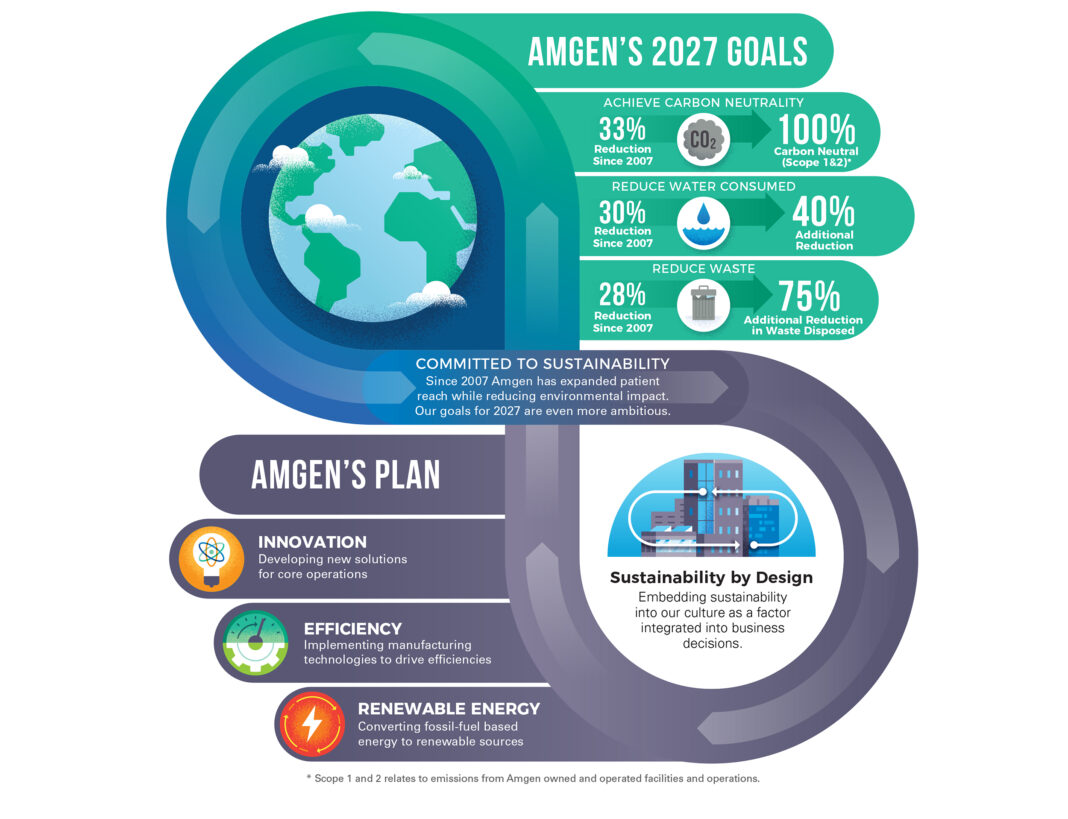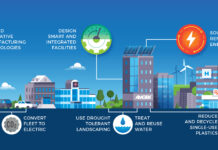
Amgen’s 2027 Environmental Sustainability Plan, also known as “The Road to Net Zero,” features ambitious targets on carbon emissions, water conservation and waste reductions. This is Amgen’s third Environmental Sustainability Plan since 2008, and the keystone of the plan is a commitment to achieving carbon neutrality in Amgen’s operations by 2027. The plan also includes goals to reduce water use by 40% and waste disposal by 75%. Amgen has embarked on a sustainability plan that is paved with innovation, efficiency and renewable energy.
Join us for a conversation with Jim Rawley, Environment, Health, Safety and Sustainability Manager and Jeff Houle, Director of Engineering at Amgen about their ongoing efforts and progress in helping to realize Amgen’s 2027 sustainability goals.
What do you see as the key trends for sustainability in 2023?
[J. Houle] At a macro level in 2023 many manufacturers, Amgen included, will continue to influence their suppliers to reduce their emissions (Scope 3 Emissions). Without looking at the total end to end supply chain, it’s tough to make a meaningful difference. At a micro level at Amgen Rhode Island, we are continuing to advance water, carbon, and waste projects to meet our 2027 goals. Specifically, we are excited to be investing in a feasibility study to further water reclamation at the site.
[J. Rawley] I see the following key trends for 2023: Waste elimination efforts will be key because of the price pressures in waste transportation and landfill fees. The landfill fees in Rhode Island have risen dramatically over the last two years and do not show any signs of slowing down. There will also be increased pressure on vendors and suppliers to reduce packaging waste. This waste is a large part of our waste stream and is delivered to our sites daily.
Click here to read more content from Amgen

What are the short-term sustainability goals for Amgen? Longer term?
[J. Rawley] Amgen seeks to be the leader amongst our peers in Environmental Sustainability. Our short-term goals are to reduce our environmental footprint by continually pursuing waste, energy, carbon, and water reductions. Amgen’s 2027 goal is to reduce water by 40%, reduce waste disposal by 75% and become carbon neutral.
[J. Houle] In addition to meeting the sustainability goals that Jim mentioned, Amgen is also implementing sustainability into the design of new buildings and systems. We are building two U.S. based plants that are being designed and built with sustainability at the forefront.
How is the current economy (i.e., high interest rates) affecting Amgen’s ability to achieve your sustainability goals?
[J. Rawley] The current economy is not affecting Amgen’s ability to achieve our sustainability goals. Amgen’s commitment is strong and unwavering. Amgen has committed to making the company carbon neutral by 2027, including a 40% reduction in water use and a 75% reduction in waste disposal, based on our 2019 baseline.
[J. Houle] It’s made it harder but it hasn’t changed our commitment. When it comes to prioritizing projects, we always look at cost vs. impact. That will never change. And the reality is, many of the sustainability projects we execute have real return on investments. Especially when you consider the volatility of energy prices over the last 18 months; executing these projects isn’t just the right thing for the environment, it’s the right thing for the business.
What are some examples of successful sustainability efforts at the company?
[J. Houle] Within my function, Facilities and Engineering, we’ve executed hundreds of sustainability projects that have collectively driven year over year improved sustainability performance. In one example, we implemented a fault detection and diagnosis program that monitors our utility systems throughout many sites across our manufacturing network. This was piloted at Amgen RI. It was extremely successful as it identifies faults and then prioritizes them for staff based on the amount of energy being wasted by the fault. An example fault would be a preheat valve leaking on an air handler. Before this program, this would likely go months, if not years before being detected. A second example project is the implementation of an automated daily demand response process that automatically adjusts set points to reduce our load during peak demand in the summer. In both cases we have used technology and data to reduce our environmental footprint.
[J. Rawley] Having vendors reuse our plastic pallets to reduce wood pallets; having landscape vendor utilize mulching mowers on lawn areas; recycling plastics into reusable materials, picnic tables and park benches made from our plastics.

Utilities Operations, Amgen
What is the employee level of engagement in sustainability efforts? Are there particular employee sustainability groups or initiatives? In-person or online forums? Shared best practices among locations or employee groups?
[J. Houle] Within my function, employee engagement is extremely high. We participate in network environmental sustainability teams, internal functional teams, and cross functional teams at the site. Many other functions, like Quality Control or Process Development, have their own sustainability teams as well where they share ideas with their same functions from across the Amgen network.
How do the sustainability practices vary/remain the same across Amgen’s locations?
[J. Rawley] All Amgen locations utilize a Global Environmental Tracking System (GETS) to track and share efforts at all the sites. Each site can view projects that are being worked on at each site and encourages sites to work together. Once a project is identified as a best practice, the sites are encouraged to work on instituting that project at their site. In addition, Amgen celebrates Earth Day, America Recycles Day, and the annual Nature Conservancy’s Coastal clean-up. Employee resource groups participate in sustainability efforts. Sustainability is included in every level of management.
[J. Houle] Our corporate strategy for the 2027 sustainability goals are the same for each site. Additionally, our corporate sustainability teams do a nice job of sharing best practices across the network. Many of our sites have different technologies and are at different points in our sustainability journeys, but when there is a best practice that can be implemented at another site, it usually is.











